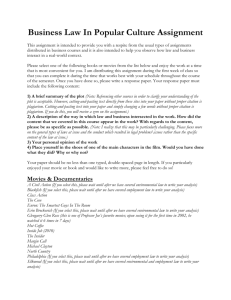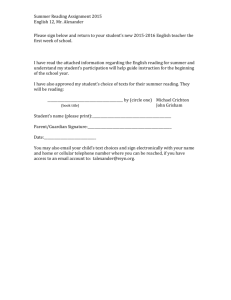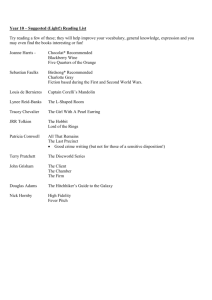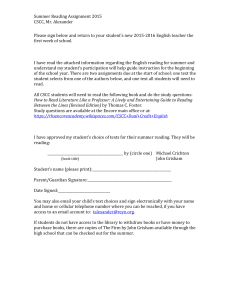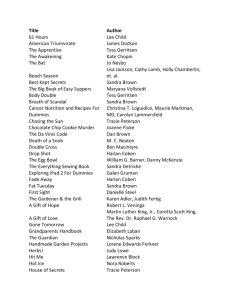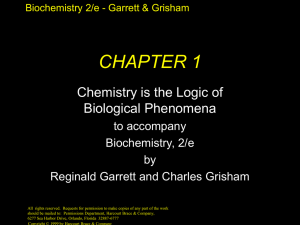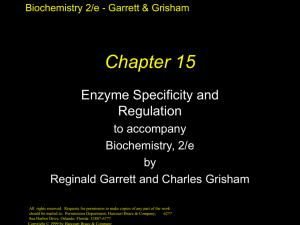Hemoglobin Powerpoint
advertisement
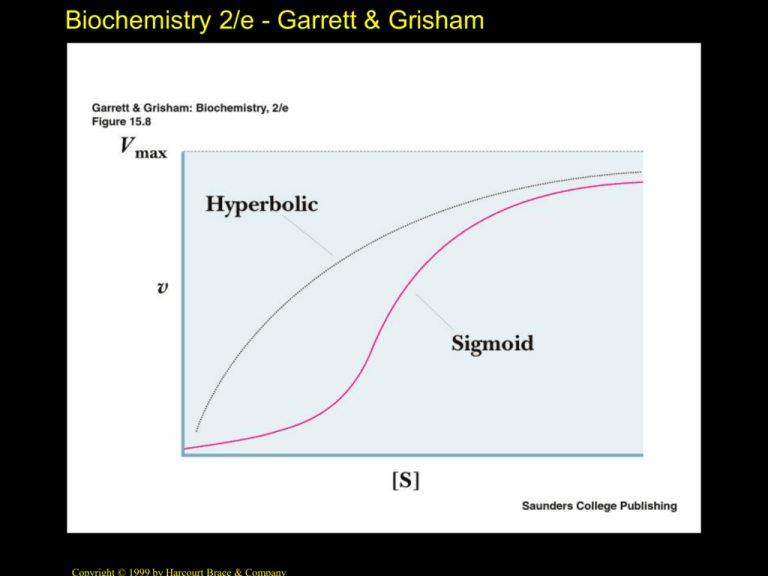
Biochemistry 2/e - Garrett & Grisham Biochemistry 2/e - Garrett & Grisham Models for Allosteric Behavior • Monod, Wyman, Changeux (MWC) Model: allosteric proteins can exist in two states: R (relaxed) and T (taut) • In this model, all the subunits of an oligomer must be in the same state • T state predominates in the absence of substrate S • S binds much tighter to R than to T Biochemistry 2/e - Garrett & Grisham More about MWC • Cooperativity is achieved because S binding increases the population of R, which increases the sites available to S • Ligands such as S are positive homotropic effectors • Molecules that influence the binding of something other than themselves are heterotropic effectors Biochemistry 2/e - Garrett & Grisham Biochemistry 2/e - Garrett & Grisham Biochemistry 2/e - Garrett & Grisham Hemoglobin • • • • • A classic example of allostery Hemoglobin and myoglobin are oxygen transport and storage proteins Compare the oxygen binding curves for hemoglobin and myoglobin Myoglobin is monomeric; hemoglobin is tetrameric Mb: 153 aa, 17,200 MW Hb: two alphas of 141 residues, 2 betas of 146 Biochemistry 2/e - Garrett & Grisham Biochemistry 2/e - Garrett & Grisham Biochemistry 2/e - Garrett & Grisham Biochemistry 2/e - Garrett & Grisham Hemoglobin Function Hb must bind oxygen in lungs and release it in capillaries • When a first oxygen binds to Fe in heme of Hb, the heme Fe is drawn into the plane of the porphyrin ring • This initiates a series of conformational changes that are transmitted to adjacent subunits Biochemistry 2/e - Garrett & Grisham Hemoglobin Function Hb must bind oxygen in lungs and release it in capillaries • Adjacent subunits' affinity for oxygen increases • This is called positive cooperativity Biochemistry 2/e - Garrett & Grisham Myoglobin Structure • • • • • Mb is a monomeric heme protein Mb polypeptide "cradles" the heme group Fe in Mb is Fe2+ - ferrous iron - the form that binds oxygen Oxidation of Fe yields 3+ charge - ferric iron -metmyoglobin does not bind oxygen Oxygen binds as the sixth ligand to Fe See Figure 15.26 and discussion of CO binding Biochemistry 2/e - Garrett & Grisham Biochemistry 2/e - Garrett & Grisham Biochemistry 2/e - Garrett & Grisham The Conformation Change • • • • • • • The secret of Mb and Hb! Oxygen binding changes the Mb conformation Without oxygen bound, Fe is out of heme plane Oxygen binding pulls the Fe into the heme plane Fe pulls its His F8 ligand along with it The F helix moves when oxygen binds Total movement of Fe is 0.029 nm - 0.29 A This change means little to Mb, but lots to Hb! Biochemistry 2/e - Garrett & Grisham Biochemistry 2/e - Garrett & Grisham Binding of Oxygen by Hb The Physiological Significance • Hb must be able to bind oxygen in the lungs • Hb must be able to release oxygen in capillaries • If Hb behaved like Mb, very little oxygen would be released in capillaries - see Figure 15.22! • The sigmoid, cooperative oxygen binding curve of Hb makes this possible! Biochemistry 2/e - Garrett & Grisham Biochemistry 2/e - Garrett & Grisham Biochemistry 2/e - Garrett & Grisham Biochemistry 2/e - Garrett & Grisham Oxygen Binding by Hb • • • • A Quaternary Structure Change When deoxy-Hb crystals are exposed to oxygen, they shatter! Evidence of a structural change! One alpha-beta pair moves relative to the other by 15 degrees upon oxygen binding This massive change is induced by movement of Fe by 0.039 nm when oxygen binds See Figure 15.32 Biochemistry 2/e - Garrett & Grisham Biochemistry 2/e - Garrett & Grisham Biochemistry 2/e - Garrett & Grisham Biochemistry 2/e - Garrett & Grisham The Bohr Effect • • • • Competition between oxygen and H+ Discovered by Christian Bohr Binding of protons diminishes oxygen binding Binding of oxygen diminishes proton binding Important physiological significance • See Figure 15.34 Biochemistry 2/e - Garrett & Grisham Biochemistry 2/e - Garrett & Grisham Bohr Effect II Carbon dioxide diminishes oxygen binding • Hydration of CO2 in tissues and extremities leads to proton production • These protons are taken up by Hb as oxygen dissociates • The reverse occurs in the lungs Biochemistry 2/e - Garrett & Grisham Biochemistry 2/e - Garrett & Grisham 2,3-Bisphosphoglycerate An Allosteric Effector of Hemoglobin • In the absence of 2,3-BPG, oxygen binding to Hb follows a rectangular hyperbola! • The sigmoid binding curve is only observed in the presence of 2,3-BPG • Since 2,3-BPG binds at a site distant from the Fe where oxygen binds, it is called an allosteric effector Biochemistry 2/e - Garrett & Grisham Biochemistry 2/e - Garrett & Grisham 2,3-BPG and Hb The "inside" story...... • Where does 2,3-BPG bind? – "Inside" – in the central cavity • What is special about 2,3-BPG? – Negative charges interact with 2 Lys, 4 His, 2 N-termini • Fetal Hb - lower affinity for 2,3-BPG, higher affinity for oxygen, so it can get oxygen from mother Biochemistry 2/e - Garrett & Grisham Biochemistry 2/e - Garrett & Grisham Biochemistry 2/e - Garrett & Grisham Biochemistry 2/e - Garrett & Grisham
